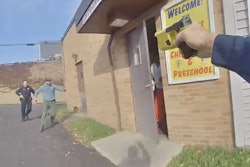 Multiple-screen VR training systems immerse officers in the scenerios.PHOTO: VirTra
Multiple-screen VR training systems immerse officers in the scenerios.PHOTO: VirTra
Proper training has always been important to police, however it has improved throughout the decades and become more realistic. Virtual reality (VR) simulators allow officers to be placed in immersive training scenarios.
But where do you start when your department is considering purchasing such equipment and what do you need to know before you buy a VR system?
“If it is a realistic virtual reality platform, which not all of them are, and it immerses the user, then people's hearts raced, they experienced heavier breathing, and they felt stressed,” says Niki Nelson, public relations and marketing specialist at VirTra. “We’ve had people that weren't police, who didn't take it seriously, and they were put in a scenario and told to act like an officer would, and they were stressed out. They couldn't believe that it was a thing that police had to deal with on the job.”
VirTra is an Arizona-based producer of multi-screen VR training systems. Its mission is to save lives by developing, manufacturing, and supporting the most powerful and immersive training simulators, scenarios, and accessories worldwide and their systems are tailored to the needs of military and law enforcement training.
The company’s ultimate goal is to train officers in VR scenarios, so they are able to return home safely every day. VR training allows officers to practice making crucial decisions during a scenario in a seemingly real-world environment, but safely.
“We invented the multi-screen simulator and went to market in the law enforcement industry with it in 2004,” explains Miranda Fuller, vice president of marketing at VirTra. “The concept was created right after 9/11, because of 9/11. We switched modes from being in the VR goggle entertainment world to speaking with law enforcement and finding out what they were missing in their training, and invented the multi-screen, multi-directional sound, and the stress inoculation tools to go in it to be the next virtual reality.”
Although the company had its roots in VR goggles, leaders at VirTra learned that cops did not want to have to train wearing goggles and Fuller points out one federal agency told them ‘We're not going to train with goggles on our face because that's not the way we fight. We train the way we fight.’”
“The thing with not having goggles on your face is you get to use your actual eyes, your hands, your alignment. And the way the simulator with the multi screens rolls out, it is a cognitive overload in a decision-making process that is not linear,” Fuller explains.
She says there are two main reasons that sum up why police chiefs buy VR training systems for their departments.
“It is consistent, and safe,” Fuller says.
Nelson recommends considering five things when purchasing a VR training system.
Her suggested things you need to know are:
1. How realistic is it?
This is the first and possibly most important question to ask before going with any VR simulation training tool. If it is unrealistic and looks more like a video game or doesn’t meet real-world task demands, trainees will not take it seriously, and potentially may be left with negative training artifacts. Also, when your officers test and evaluate the VR system, check to confirm none have experienced simulation sickness.
2. How relevant is the content?
As training needs change and evolve with time, so should the content of your training. With new laws and media attention, training priorities and needed scenarios can shift quickly. Make sure that your training platform can keep up by either receiving annual updates or being able to download new content.
3. Is the training transferable?
It is not really “training” if recruits and officers are not gaining any skills or knowledge – it’s just a “check the box” style of learning that is only completed to meet requirements. When officers are really prepared for the field, it will show in their performance both in and out of the training room. If officers are recalling skills learned from the training program and applying them to real life, it is safe to say it is an effective method. If you can not 100% guarantee accurate weapon tracking, you may be building bad skills during a VR training scenario.
4. Can you use the same tools you use on the job?
We have all seen colorful training pistols or VR controllers, but they don’t recoil and often don’t even have the same weight and fit as the officer’s duty weapon. In addition to firearms, you should be able to train with all the tools on your duty belt. This includes CEW devices, OC spray, flashlights, and even just using your verbal de-escalation techniques.
5. Are there flexible pricing options?
When purchasing a VR training tool, are their choices beyond just making an upfront capital purchase? See if there are options for obtaining grants, or even if the VR company has promotions or leasing opportunities. Many agencies are tight on cash these days, but that shouldn’t stop you from being able to obtain effective training. Spending more on training means less possibility of costly failure-to-train lawsuits.
















